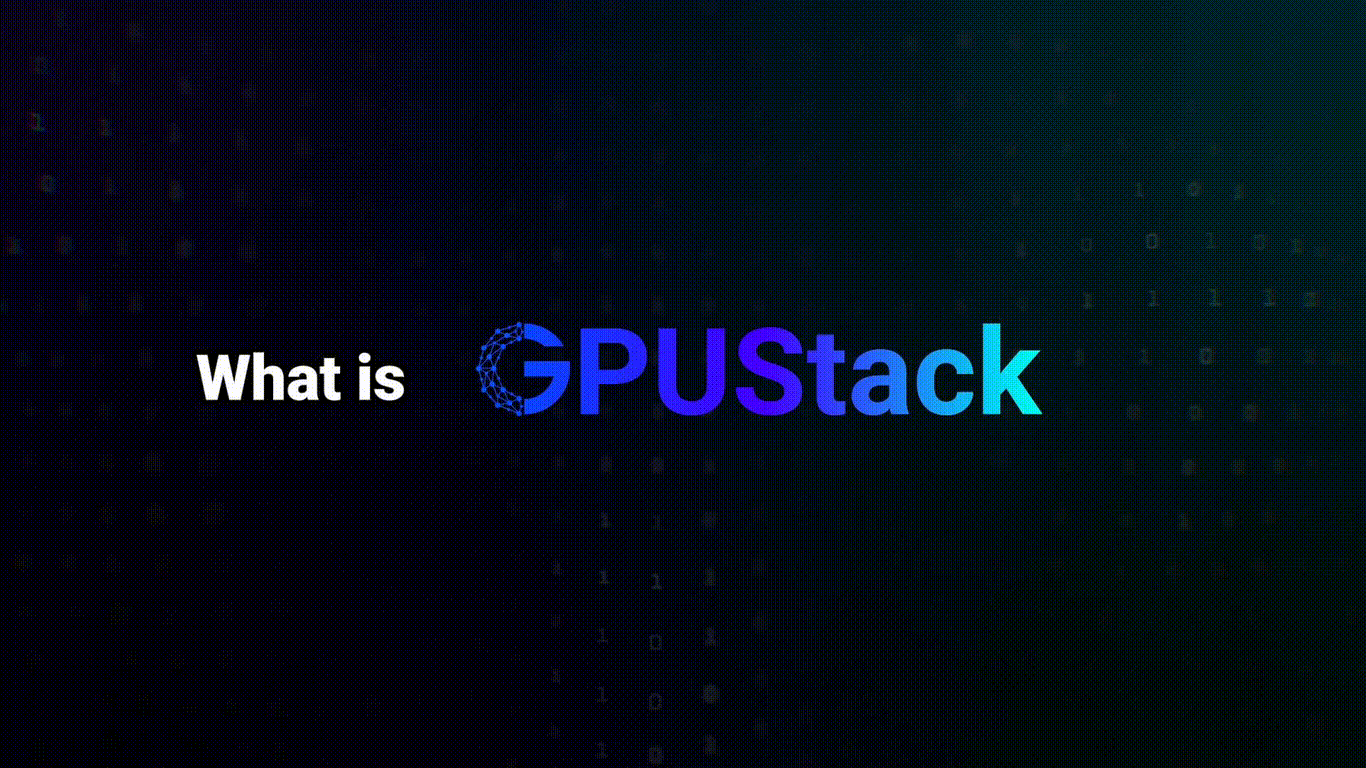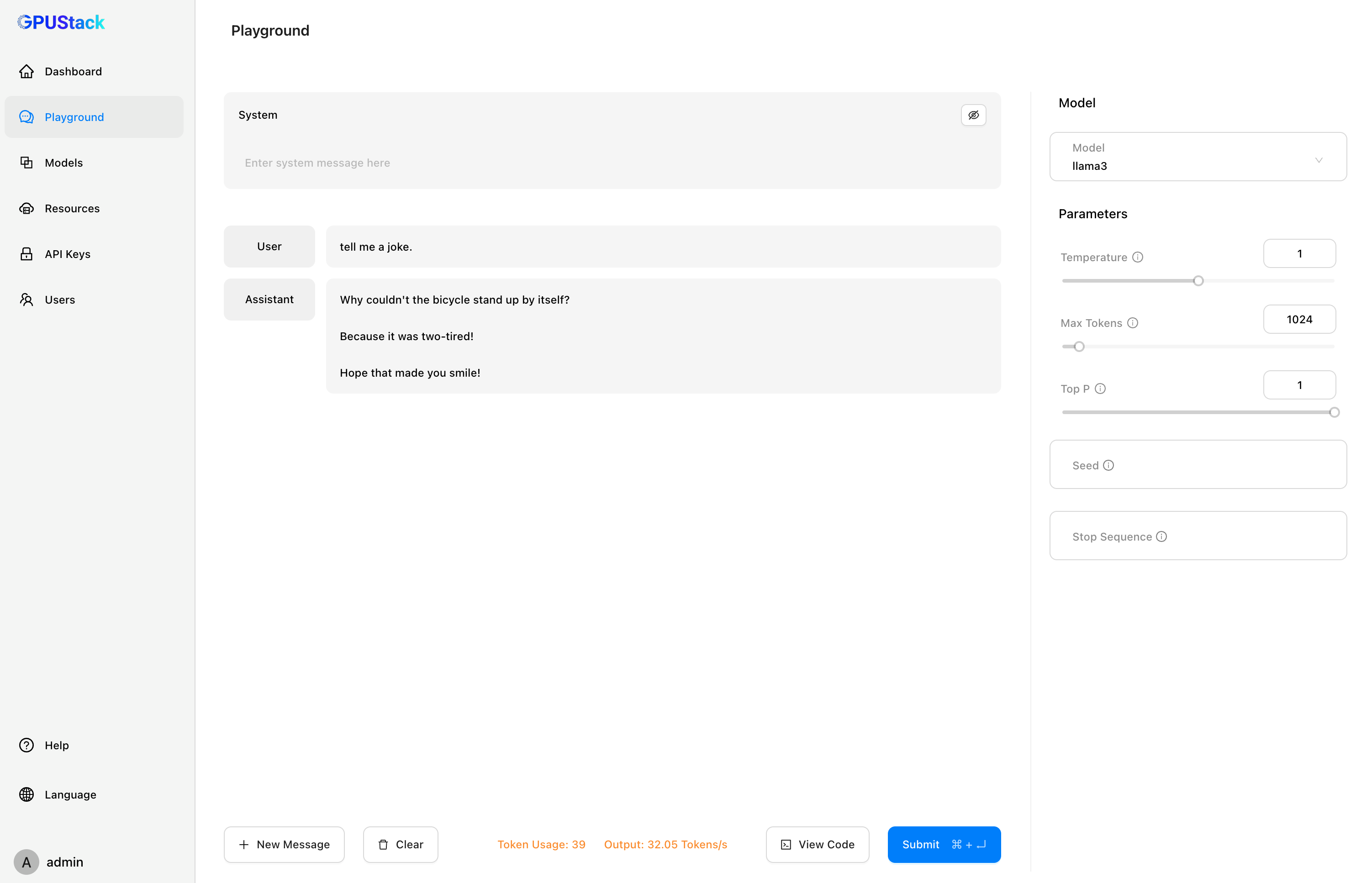GPUStack is an open-source GPU cluster manager for running large language models(LLMs).
- Supports a Wide Variety of Hardware: Run with different brands of GPUs in Apple MacBooks, Windows PCs, and Linux servers.
- Scales with Your GPU Inventory: Easily add more GPUs or nodes to scale up your operations.
- Lightweight Python Package: Minimal dependencies and operational overhead.
- OpenAI-compatible APIs: Serve APIs that are compatible with OpenAI standards.
- User and API key management: Simplified management of users and API keys.
- GPU metrics monitoring: Monitor GPU performance and utilization in real-time.
- Token usage and rate metrics: Track token usage and manage rate limits effectively.
GPUStack provides a script to install it as a service on systemd or launchd based systems. To install GPUStack using this method, just run:
curl -sfL https://get.gpustack.ai | sh -s -Optionally, you can add extra workers to form a GPUStack cluster by running the following command on other nodes (replace http://myserver and mytoken with your actual server URL and token):
curl -sfL https://get.gpustack.ai | sh -s - --server-url http://myserver --token mytokenIn the default setup, you can run the following to get the token used for adding workers:
cat /var/lib/gpustack/tokenRun PowerShell as administrator, then run the following command to install GPUStack:
Invoke-Expression (Invoke-WebRequest -Uri "https://get.gpustack.ai" -UseBasicParsing).ContentOptionally, you can add extra workers to form a GPUStack cluster by running the following command on other nodes (replace http://myserver and mytoken with your actual server URL and token):
Invoke-Expression "& { $((Invoke-WebRequest -Uri 'https://get.gpustack.ai' -UseBasicParsing).Content) } -server-url http://myserver -token mytoken"In the default setup, you can run the following to get the token used for adding workers:
Get-Content -Path "$env:APPDATA\gpustack\token" -RawFor manual installation or detailed configurations, refer to the installation docs.
- Run and chat with the llama3 model:
gpustack chat llama3 "tell me a joke."- Open
http://myserverin the browser to access the GPUStack UI. Log in to GPUStack with usernameadminand the default password. You can run the following command to get the password for the default setup:
Linux or MacOS
cat /var/lib/gpustack/initial_admin_passwordWindows
Get-Content -Path "$env:APPDATA\gpustack\initial_admin_password" -Raw- Click
Playgroundin the navigation menus. Now you can chat with the LLM in the UI playground.
-
Click
API Keysin the navigation menus, then click theNew API Keybutton. -
Fill in the
Nameand click theSavebutton. -
Copy the generated API key and save it somewhere safe. Please note that you can only see it once on creation.
-
Now you can use the API key to access the OpenAI-compatible API. For example, use curl as the following:
export GPUSTACK_API_KEY=myapikey
curl http://myserver/v1-openai/chat/completions \
-H "Content-Type: application/json" \
-H "Authorization: Bearer $GPUSTACK_API_KEY" \
-d '{
"model": "llama3",
"messages": [
{
"role": "system",
"content": "You are a helpful assistant."
},
{
"role": "user",
"content": "Hello!"
}
],
"stream": true
}'- MacOS
- Linux
- Windows
- Apple Metal
- NVIDIA CUDA
We plan to support the following accelerators in future releases.
- AMD ROCm
- Intel oneAPI
- Qualcomm AI Engine
GPUStack uses llama.cpp as the backend and supports large language models in GGUF format. Models from the following sources are supported:
Here are some example models:
- LLaMA
- Mistral 7B
- Mixtral MoE
- DBRX
- Falcon
- Baichuan
- Aquila
- Yi
- StableLM
- Deepseek
- Qwen
- Phi
- Gemma
- Mamba
- Grok-1
GPUStack serves the following OpenAI compatible APIs under the /v1-openai path:
- List models
- Chat completions
For example, you can use the official OpenAI Python API library to consume the APIs:
from openai import OpenAI
client = OpenAI(base_url="http://myserver/v1-openai", api_key="myapikey")
completion = client.chat.completions.create(
model="llama3",
messages=[
{"role": "system", "content": "You are a helpful assistant."},
{"role": "user", "content": "Hello!"}
]
)
print(completion.choices[0].message)GPUStack users can generate their own API keys in the UI.
Please see the official docs site for complete documentation.
-
Install
python 3.10+. -
Run
make build.
You can find the built wheel package in dist directory.
Please read the Contributing Guide if you're interested in contributing to GPUStack.
Copyright (c) 2024 The GPUStack authors
Licensed under the Apache License, Version 2.0 (the "License"); you may not use this file except in compliance with the License. You may obtain a copy of the License at LICENSE file for details.
Unless required by applicable law or agreed to in writing, software distributed under the License is distributed on an "AS IS" BASIS, WITHOUT WARRANTIES OR CONDITIONS OF ANY KIND, either express or implied. See the License for the specific language governing permissions and limitations under the License.

